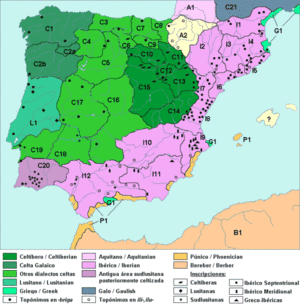阿基坦语
外观
| 阿基坦语 | |
|---|---|
| 母语国家和地区 | 法国、西班牙 |
| 区域 | 比利牛斯山以西 |
| 语言灭亡 | 中世纪早期 |
| 语系 | 瓦斯科尼亚语系 |
| 语言代码 | |
| ISO 639-3 | xaq |

阿基坦语,是古阿基坦民族的语言,在被罗马征服前的中世纪早期或者更晚的这一段时间,古阿基坦地区所使用的的语言。该地区位于比利牛斯山脉和加龙河之间,后来被称作加斯科涅。
在考古学、地名学和历史学上的证据都表明,阿基坦语是属于瓦斯科尼亚语系、巴斯克语的先导族语群。
历史
[编辑]西欧地区的阿基坦语和巴斯克语被通常认为是在欧洲,以印欧人为主的语系之外的地方语言。
与其他语言的关系
[编辑]从巴斯克语的角度来看,大多数阿基坦语专名元素都可以清楚地识别出来,与瓦斯科尼亚学家科尔多·米切莱纳为原始巴斯克语重建的形式紧密匹配:
| 阿基坦语 | 原始巴斯克语 | 巴斯克语 | 巴斯克语词意 |
|---|---|---|---|
| adin | *adiN | adin | 年龄,判断力 |
| andere, er(h)e | *andere | andre | 夫人,女人 |
| andos(s), andox | *andoś | 主 | |
| arix | *aris | aritz | 橡树 |
| artahe, artehe | *artehe | arte | 冬青橡木 |
| atta | *aTa | aita | 父亲 |
| belex | ?*beLe | bele | 乌鸦 |
| bels | *bels | beltz | 黑色 |
| bihox, bihos | *bihos | bihotz | 心 |
| bon, -pon | *boN | on | 很好 |
| bors | *bors | bortz | 五 |
| cis(s)on, gison | *gisoN | gizon | 男人 |
| -c(c)o | *-Ko | -ko | 指小后缀 |
| corri, gorri | *goRi | gorri | 红色 |
| hals- | *hals | haltza | 岁 |
| han(n)a | ?*aNane | anaia | 兄弟 |
| har-, -ar | *aR | ar | 男性 |
| hars- | *hars | hartz | 承担 |
| heraus- | *herauś | herauts | 公猪 |
| il(l)un, ilur | *iLun | il(h)un | 黑暗 |
| leher | *leheR | leher | 松树 |
| nescato | *neśka | neska, neskato | 女孩,年轻女子 |
| ombe, umme | *unbe | ume | 孩子 |
| oxson, osson | *otso | otso | 狼 |
| sahar | *sahaR | zahar | 年老 |
| sembe | *senbe | seme | 儿子 |
| seni | *śeni | sein | 男孩 |
| -ten | *-teN | -ten | 指小后缀 (固定式) |
| -t(t)o | *-To | -t(t)o | 指小后缀 |
| -x(s)o | *-tso | -txo,-txu | 指小后缀 |
瓦斯科尼亚学家华金·戈罗查特吉就著有诸多关于阿基坦语的著作,米切莱纳曾指出一些伊比利语的专有名词与阿基坦语有诸多的相似性 ,特别是专有名称:
| 伊比利语 | 阿基坦语 |
|---|---|
| atin | adin |
| ata | atta |
| baiser | baese-, bais- |
| beleś | belex |
| bels | bels |
| boś | box |
| lauŕ | laur |
| talsku | talsco/ HALSCO |
| taŕ | t(h)ar / HAR |
| tautin | tautinn / hauten |
| tetel | tetel |
| uŕke | urcha |
参见
[编辑]延伸阅读
[编辑]- Ballester, Xaverio (2001): "La adfinitas de las lenguas aquitana e ibérica", Palaeohispanica 1, pp. 21–33.
- Gorrochategui, Joaquín (1984): Onomástica indígena de Aquitania, Bilbao.
- Gorrochategui, Joaquín (1993): La onomástica aquitana y su relación con la ibérica, Lengua y cultura en Hispania prerromana : actas del V Coloquio sobre lenguas y culturas de la Península Ibérica : (Colonia 25–28 de Noviembre de 1989) (Francisco Villar and Jürgen Untermann, eds.), ISBN 84-7481-736-6, pp. 609–34
- Gorrochategui, Joaquín (1995): "The Basque Language and its Neighbors in Antiquity", Towards a History of the Basque Language, pp. 31–63.
- Hoz, Javier de (1995): "El poblamiento antiguo de los Pirineos desde el punto de vista lingüístico", Muntanyes i Població. El passat dels Pirineus des d'una perspectiva multidisciplinària, pp. 271–97.
- Michelena, Luis (1954): "De onomástica aquitana", Pirineos 10, pp. 409–58.
- Michelena, Luis (1977): Fonética histórica vasca, San Sebastián.
- Núñez, Luis (2003): El Euskera arcaico. Extensión y parentescos (页面存档备份,存于互联网档案馆), Tafalla.
- Rodríguez Ramos, Jesús (2002): "La hipótesis del vascoiberismo desde el punto de vista de la epigrafía íbera", Fontes Linguae Vasconum 90, pp. 197–219.
- Rodríguez Ramos, Jesús (2002): "Índice crítico de formantes de compuesto de tipo onomástico en la lengua íbera", Cypsela 14, pp. 251–75.
- Trask, L.R. (1995): "Origin and relatives of the Basque Language: Review of the evidence", Towards a History of the Basque Language, pp. 65–99.
- Trask, L.R. (1997): The History of Basque, London/New York, ISBN 0-415-13116-2
- Trask, L.R. (2008): Etymological Dictionary of BasquePDF (edited for web publication by Max Wheeler), University of Sussex
- Velaza, Javier (1995): "Epigrafía y dominios lingüísticos en territorio de los vascones", Roma y el nacimiento de la cultura epigráfica en occidente, pp. 209–18.
外部链接
[编辑]- Aquitanian Language by Jesús Rodríguez Ramos
